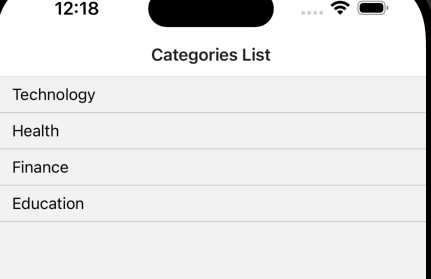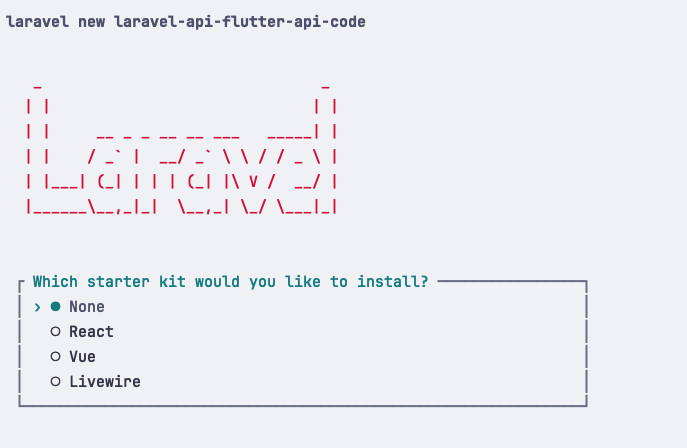We will start our course from creating Laravel API for two Models: Categories and Transactions. In the following sections, we will start creating a React Native mobile application which would use this API.
This is how our mobile app screen will look like, after consuming API for Categories:

Next, we build a Laravel project for the API.
Notice: The Laravel part is identical to the API we created in earlier Laravel API + Flutter course, we will even re-use the same GitHub repository. So if you are coming from there and have the API created, you can skip to the next section with React Native lessons.
Creating a new Laravel Project
Let's start by creating a new Laravel project. Open your terminal and run the following command:
laravel new laravel-api-flutter-api-codeNotice: again, you see the word "flutter" here but this is because we're re-using the same Laravel API lessons from Flutter + Laravel course.
Then we will select None as our Starter kit:

Creating our First Model and Migration
Let's create our first model and migration for our categories. Run the following command:
php artisan make:model Category -mThen we fill in our fields:
Migration
Schema::create('categories', function (Blueprint $table) { $table->id(); $table->foreignId('user_id')->nullable()->constrained(); $table->string('name'); $table->timestamps();});Then, we prepare our model:
app/Models/Category.php
use Illuminate\Database\Eloquent\Factories\HasFactory;use Illuminate\Database\Eloquent\Model;use Illuminate\Database\Eloquent\Relations\BelongsTo; class Category extends Model{ use HasFactory; protected $fillable = [ 'user_id', 'name', ]; public function user(): BelongsTo { return $this->belongsTo(User::class); }}Creating a Controller
Let's create our API Resource Controller for our categories. Run the following command:
php artisan make:controller Api/CategoryController --resource --api --model=CategoryThis will create a new controller with all the necessary methods for our CRUD:
app/Http/Controllers/Api/CategoryController.php
use App\Http\Controllers\Controller;use App\Models\Category;use Illuminate\Http\Request; class CategoryController extends Controller{ /** * Display a listing of the resource. */ public function index() { // } /** * Store a newly created resource in storage. */ public function store(Request $request) { // } /** * Display the specified resource. */ public function show(Category $category) { // } /** * Update the specified resource in storage. */ public function update(Request $request, Category $category) { // } /** * Remove the specified resource from storage. */ public function destroy(Category $category) { // }}Returning First API Response
To keep this simple, we will add the...

Thank you for this course and all the other ones! I've learned so much. I created a React Native starter app from what I learned. I'll share it here in case it can help anyone else.
https://github.com/genonline/react-native-laravel-starter-kit